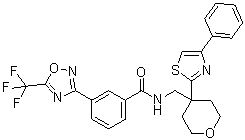TMP269 is a novel, potent, selective inhibitor of class IIa HDAC(4/5/7/9) with potential anticancer activity. It blocks HDAC(4/5/7/9) with IC50 of 157 nM, 97 nM, 43 nM and 23 nM, respectively.
Physicochemical Properties
| Molecular Formula | C25H21F3N4O3S | |
| Molecular Weight | 514.52 | |
| Exact Mass | 514.128 | |
| Elemental Analysis | C, 58.36; H, 4.11; F, 11.08; N, 10.89; O, 9.33; S, 6.23 | |
| CAS # | 1314890-29-3 | |
| Related CAS # |
|
|
| PubChem CID | 53344908 | |
| Appearance | White to off-white solid powder | |
| Density | 1.3±0.1 g/cm3 | |
| Index of Refraction | 1.574 | |
| LogP | 5.81 | |
| Hydrogen Bond Donor Count | 1 | |
| Hydrogen Bond Acceptor Count | 10 | |
| Rotatable Bond Count | 6 | |
| Heavy Atom Count | 36 | |
| Complexity | 749 | |
| Defined Atom Stereocenter Count | 0 | |
| SMILES | S1C([H])=C(C2C([H])=C([H])C([H])=C([H])C=2[H])N=C1C1(C([H])([H])N([H])C(C2=C([H])C([H])=C([H])C(C3=NOC(C(F)(F)F)=N3)=C2[H])=O)C([H])([H])C([H])([H])OC([H])([H])C1([H])[H] |
|
| InChi Key | HORXBWNTEDOVKN-UHFFFAOYSA-N | |
| InChi Code | InChI=1S/C25H21F3N4O3S/c26-25(27,28)22-31-20(32-35-22)17-7-4-8-18(13-17)21(33)29-15-24(9-11-34-12-10-24)23-30-19(14-36-23)16-5-2-1-3-6-16/h1-8,13-14H,9-12,15H2,(H,29,33) | |
| Chemical Name | N-[[4-(4-phenyl-1,3-thiazol-2-yl)oxan-4-yl]methyl]-3-[5-(trifluoromethyl)-1,2,4-oxadiazol-3-yl]benzamide | |
| Synonyms |
|
|
| HS Tariff Code | 2934.99.9001 | |
| Storage |
Powder-20°C 3 years 4°C 2 years In solvent -80°C 6 months -20°C 1 month |
|
| Shipping Condition | Room temperature (This product is stable at ambient temperature for a few days during ordinary shipping and time spent in Customs) |
Biological Activity
| Targets | HDAC9 ( IC50 = 23 nM ); HDAC7 ( IC50 = 43 nM ); HDAC5 ( IC50 = 97 nM ); HDAC4 ( IC50 = 157 nM ); HDAC8 ( IC50 = 42000 nM ); HDAC6 ( IC50 = 82000 nM ) | ||
| ln Vitro |
|
||
| ln Vivo |
|
||
| Enzyme Assay | At Reaction Biology Corp., dose-response studies are carried out using ten concentrations in a triplicate dilution series, starting from a maximum final compound concentration of 100 μM in the reaction mixture. The same basic idea underlies all assays, including the HDAC9 assay previously mentioned: HDAC deacetylates acetylated or trifluoroacetylated lysine residues on fluorogenic peptide substrates. The substrate used by HDAC1, HDAC2, HDAC3, HDAC6, HDAC10, and HDAC11 was based on p53 residues 379–382 (Arg–His–Lys–Lys(Ac)). The diacetylated peptide substrate for HDAC8 is Arg-His-Lys(Ac)-Lys(Ac) and is based on residues 379–382 of p53. The class IIa HDAC-specific fluorogenic substrate, Boc-Lys(trifluoroacetyl)-AMC, was utilized in the HDAC4, HDAC5, HDAC7, and HDAC9 assays. Assay buffer (50 mM Tris-HCl, pH 8.0, 137 mM NaCl, 2.7 mM KCl, 1 mM MgCl2, 1 mg/mL BSA) containing 1% DMSO final concentration is used for all reactions. 50 μM HDAC substrate is used in these reactions, which are then incubated for two hours at 30 °C and developed using trichostatin A and trypsin. | ||
| Cell Assay | The RosetteSep Human CD4+ T cell enrichment kit's manufacturer's instructions are followed to isolate human CD4+ T cells from whole blood via negative selection. The cells are then re-suspended in T-cell culture medium (10% FBS, 2 mM L-glutamine, 1 mM pyruvate, 10 mM HEPES, 10 U/10 mg penicillin/streptomycin, 0.5% DMSO in RPMI) and plated at 50,000 cells/well with IL-2 (10 BRMP units/mL) and 100,000 human T-expander Dynabeads for a 72-hour period. According to the manufacturer's instructions (Cell Proliferation Assay Kit I (MTT)), mitochondrial function or cell viability is determined and is expressed as a percentage of control (no inhibitor) wells. | ||
| Animal Protocol |
|
||
| References |
[1]. Nat Chem Biol . 2013 May;9(5):319-25. [2]. Am J Physiol Cell Physiol . 2014 May 15;306(10):C961-71. [3]. Biochem Biophys Res Commun . 2018 Sep 5;503(2):1087-1091. |
||
| Additional Infomation | TMP269 is a novel and selective class IIa histone deacetylase (HDAC) inhibitor. |
Solubility Data
| Solubility (In Vitro) |
|
|||
| Solubility (In Vivo) |
Solubility in Formulation 1: ≥ 2.5 mg/mL (4.86 mM) (saturation unknown) in 10% DMSO + 40% PEG300 +5% Tween-80 + 45% Saline (add these co-solvents sequentially from left to right, and one by one), clear solution. For example, if 1 mL of working solution is to be prepared, you can add 100 μL of 25.0 mg/mL clear DMSO stock solution to 400 μL PEG300 and mix evenly; then add 50 μL Tween-80 + to the above solution and mix evenly; then add 450 μL normal saline to adjust the volume to 1 mL. Preparation of saline: Dissolve 0.9 g of sodium chloride in 100 mL ddH₂ O to obtain a clear solution. (Please use freshly prepared in vivo formulations for optimal results.) |
| Preparing Stock Solutions | 1 mg | 5 mg | 10 mg | |
| 1 mM | 1.9436 mL | 9.7178 mL | 19.4356 mL | |
| 5 mM | 0.3887 mL | 1.9436 mL | 3.8871 mL | |
| 10 mM | 0.1944 mL | 0.9718 mL | 1.9436 mL |
